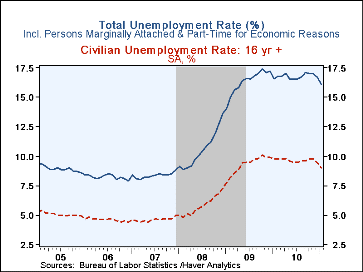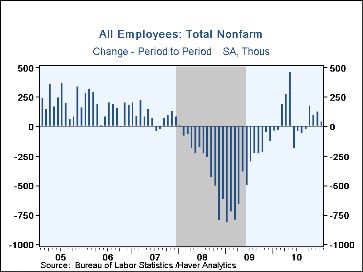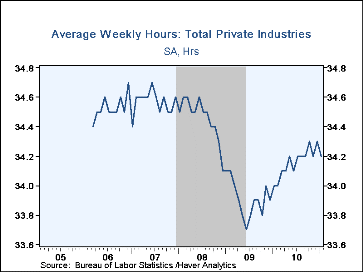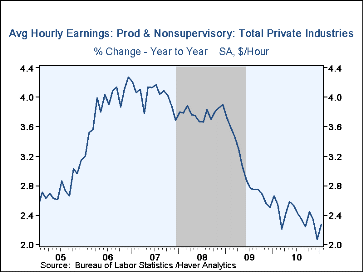 Global| Feb 04 2011
Global| Feb 04 2011U.S. Payroll Increase Disappoints But Unemployment Rate Falls
by:Tom Moeller
|in:Economy in Brief
Summary
Record snowfalls depressed hiring last month. Nonfarm payrolls increased just 36,000 last month after upwardly revised gains of 121,000 in December and 93,000 in November. Nevertheless, the rise disappointed Consensus forecasts for a [...]
Record snowfalls depressed hiring last month. Nonfarm payrolls
increased just 36,000 last month after upwardly revised gains of 121,000 in December and 93,000 in November. Nevertheless, the rise disappointed Consensus forecasts for a
136,000
gain and it left three-month growth in private payrolls at 0.8% (AR). Revisions
to prior years' figures indicated slightly deeper declines in payrolls. Perhaps
offsetting the disappointment was the decline
in the unemployment rate to 9.0% versus expectations for 9.5%. Here again,
however, there was a huge weather influence.
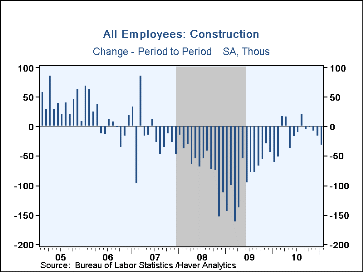
From the establishment jobs survey, poor weather's effect in reducing the overall gain in payrolls to 36,000 is clear. Construction jobs fell 32,000, courier/messenger employment dropped 44,800 and temporary jobs were off 11,000. Factory sector jobs posted their largest gain of the economic recovery with a 49,000 increase (1.3% y/y) but government jobs fell 14,000 (-1.1% y/y). Local gov't employment fell 10,000 (-1.6% y/y), federal gov't jobs fell 2,000 (-0.6% y/y) and state government jobs also slipped 2,000 (0.0% y/y).
The length of the average workweek in the private sector fell to 34.2 hours though that remained up from the 2009 low of 33.7. The construction industry workweek fell hard to 37.3, down nearly a full hour to its lowest since last February. The factory workweek returned to its cycle high as did the workweek in private service producing industries.
Average hourly earnings rose 0.5%, an increase which still left the y/y gain of 2.3% just above the cycle low of 2.1%. Wages in manufacturing rose 2.4% y/y, private service wages rose 2.2% y/y and construction sector wages rose 2.0% y/y.
The 9.0% unemployment rate, derived from the household survey of jobs, dropped sharply to its lowest since April 2009. The decline reflected a 117,000 increase (0.6% y/y) in employment. More impressive, however, was a huge, weather-related 504,000 (-0.1% y/y) drop in the labor force. The labor force participation rate fell to 64.2%, its lowest since 1984. The more comprehensive unemployment rate fell to 16.1%. This measure includes marginally attached workers and those who work part-time but would prefer a full-time job.
The household survey also showed that the average duration of unemployment jumped to a record 36.9 weeks. Of those unemployed, 43.8% were out of work for 27 weeks or longer. By educational attainment, the unemployment rate ranged from a reduced 14.2% for persons without a high school diploma to 4.2% for those with a college degree or higher
The figures referenced above are available in Haver's USECON database. Additional detail can be found in the LABOR and in the EMPL databases.
The Economic Outlook and Macroeconomic Policy is yesterday's speech by Federal Reserve Chairman Ben S. Bernanke and it is available here.
| Employment: (M/M Chg., 000s) | Jan | Dec | Nov | Y/Y | 2010 | 2009 | 2008 |
|---|---|---|---|---|---|---|---|
| Payroll Employment | 36 | 121 | 93 | 0.8% | -0.7% | -4.4% | -0.6% |
| Previous | -- | 103 | 71 | -- | -0.5% | -4.3% | -0.6% |
| Manufacturing | 49 | 14 | 15 | 1.3% | -2.7% | -11.6% | -3.4% |
| Construction | -32 | -17 | -8 | -2.3% | -8.1% | -16.0% | -6.1% |
| Private Service Producing | 32 | 146 | 120 | 1.3% | -0.1% | -3.5% | -0.2% |
| Government | -14 | -18 | -35 | -1.1% | -0.3% | 0.3% | 1.3% |
| Average Weekly Hours | 34.2 | 34.3 | 34.2 | 34.0 (Jan.'10) |
34.2 | 33.9 | 34.5 |
| Average Hourly Earnings | 0.5% | 0.0% | 0.1% | 2.3% | 2.4% | 3.0% | 3.8% |
| Unemployment Rate (%) | 9.0 | 9.4 | 9.8 | 9.7 (Jan.'10) |
9.6 | 9.3 | 5.8 |
Tom Moeller
AuthorMore in Author Profile »Prior to joining Haver Analytics in 2000, Mr. Moeller worked as the Economist at Chancellor Capital Management from 1985 to 1999. There, he developed comprehensive economic forecasts and interpreted economic data for equity and fixed income portfolio managers. Also at Chancellor, Mr. Moeller worked as an equity analyst and was responsible for researching and rating companies in the economically sensitive automobile and housing industries for investment in Chancellor’s equity portfolio. Prior to joining Chancellor, Mr. Moeller was an Economist at Citibank from 1979 to 1984. He also analyzed pricing behavior in the metals industry for the Council on Wage and Price Stability in Washington, D.C. In 1999, Mr. Moeller received the award for most accurate forecast from the Forecasters' Club of New York. From 1990 to 1992 he was President of the New York Association for Business Economists. Mr. Moeller earned an M.B.A. in Finance from Fordham University, where he graduated in 1987. He holds a Bachelor of Arts in Economics from George Washington University.


